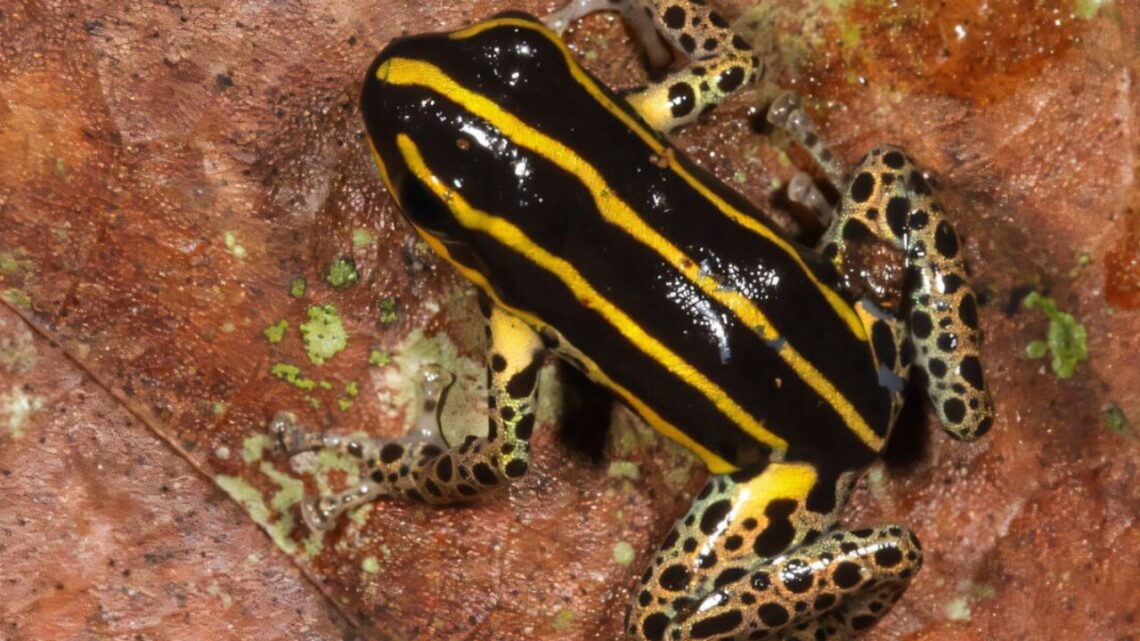The Amazon rainforest has done it again! Scientists have found a new poison dart frog species in Peru’s Amazon, adding one more name to the long list of amazing animals that live there. This new frog, called Ranitomeya hwata, is tiny, colourful, and full of surprises.
Discovery in the Jungle
The discovery was made by a group of scientists from Peru, Germany, Brazil, the United States, and Spain. They found the frog while studying the forests inside Alto Purus National Park, a huge protected area near the border of Brazil.
Local researchers Giussepe Gagliardi-Urrutia, Juan C. Chaparro, and Roberto Gutiérrez Poblete were part of the team. They shared their findings in the scientific journal Zootaxa, and Peru’s National Service of Protected Natural Areas announced the discovery to the public.
This small frog might be new to science, but it has lived quietly in the jungle for a very long time. Its tiny size and hidden home helped it stay unnoticed until now.
What Makes It Special
The Ranitomeya hwata is only about 15 millimeters long—smaller than a fingernail! It is known as the smallest frog in its genus. Even though it’s tiny, its colours make it stand out. It has bright yellow stripes on its back, a spotted belly, and a black band across its throat.
These bright colours are not just for decoration—they are a warning to predators. Like other poison dart frogs, this one produces natural toxins that make it unsafe to eat. The beautiful colours send a clear message: stay away!
Home in the Bamboo Forest
The frog lives mainly in bamboo groves belonging to the Guadua plant family. These plants are hollow, and when it rains, water collects inside the stems. That is where these frogs live and breed.
The frogs lay their eggs inside the bamboo stems. The small pools of water give the tadpoles a safe place to grow. What makes the Ranitomeya hwata unique is the male’s behaviour—instead of pairing with one female, the male calls several females to one breeding spot. This is unusual among poison dart frogs.
Where It Was Found
Alto Purus National Park is a remote and quiet part of eastern Peru. It covers land in the Ucayali and Madre de Dios regions. Because of its distance from human activity, many parts of the park remain unexplored. That’s one reason this species stayed hidden for so long.
Quick Facts About Ranitomeya hwata
| Feature | Details |
|---|---|
| Species name | Ranitomeya hwata |
| Size | About 15 millimeters |
| Colour | Yellow stripes, spotted belly, black throat band |
| Habitat | Bamboo groves (Guadua family) |
| Breeding | Eggs inside bamboo stems, male calls multiple females |
| Location | Alto Purus National Park, Peru |
| Importance | Adds to Amazon biodiversity and helps scientific study |
Why It Matters
This discovery reminds us that the Amazon is still full of mysteries. Even in well-studied regions, scientists can still find new animals. Every new discovery like this teaches us more about how the Amazon ecosystem works.
Protected parks like Alto Purus are also very important. They give animals safe places to live away from dangers like logging, pollution, and climate change. Learning about creatures such as Ranitomeya hwata helps people understand why wildlife conservation is so important.
The discovery of Ranitomeya hwata shows that the world still has many secrets waiting to be uncovered. This tiny frog, hidden deep inside Peru’s Amazon, is proof that nature continues to surprise us.
Its discovery is a reminder that we must protect forests and wildlife because they hold answers to how life on Earth adapts and survives. By saving these habitats, we keep the planet full of colour, sound, and life for generations to come.









